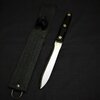If you can kill a hog with a flint knife, then does that make it a fighting knife?
 Hog hunting Caveman style!
Hog hunting Caveman style!
Have to wonder how many more cooking careers were ended with one of these

than men killed in combat with a "fighting knife"

Randall had a small room, connected to the sales room, full of old stuff and letters from service men describing various situations in which a Randall knife was used in anger. It had to be good for sales.
Sammy claimed to have killed a Japanese solider attempting to bayonet him, on Iwo Jima, with this knife

Sammy showed me the still existing bayonet wound in his left arm and side, where the bayoneteer had got him with the long bayonet on his Arisaka. That left Sammy's right side free to stab the Japanese solider with his right hand.
Sammy also left me feel the bump on his head where Japanese bayoneteer #2 hit his with his rifle butt, stunning Sammy and knocking him down. When I asked why he was not dead, Sammy said "those Marines over there got him"
This is an extremely rare Vietnam special forces type knife


Notice: no markings!
My bud Danny Boy, with whom I bunked with at Camp Perry, was issued this thing in Vietnam and never liked it. This is his second, the first broke its tip cutting saw grass. So, Danny Boy, who was Special Forces imbedded with the
Hmong Vietnamese, carried this Kabar

because it would slice the bread in a type C rations can.
So, is the second a fighting knife? Danny Boy claimed it would put a real hurt on someone.
The Hmong were given to believe that once they helped the Americans beat the North Vietnamese, that America would help them to create their own country, independent of South Vietnam. Of course, not only did that not happen, it would not have happened. The US just lied to them to get them to use their knowledge of the area, and guerrilla tactics, to fight the North Vietnamese. Danny described an intelligence probe where he was the only American with a group of 200 Hmong. No South Vietnamese were along for the recon.














